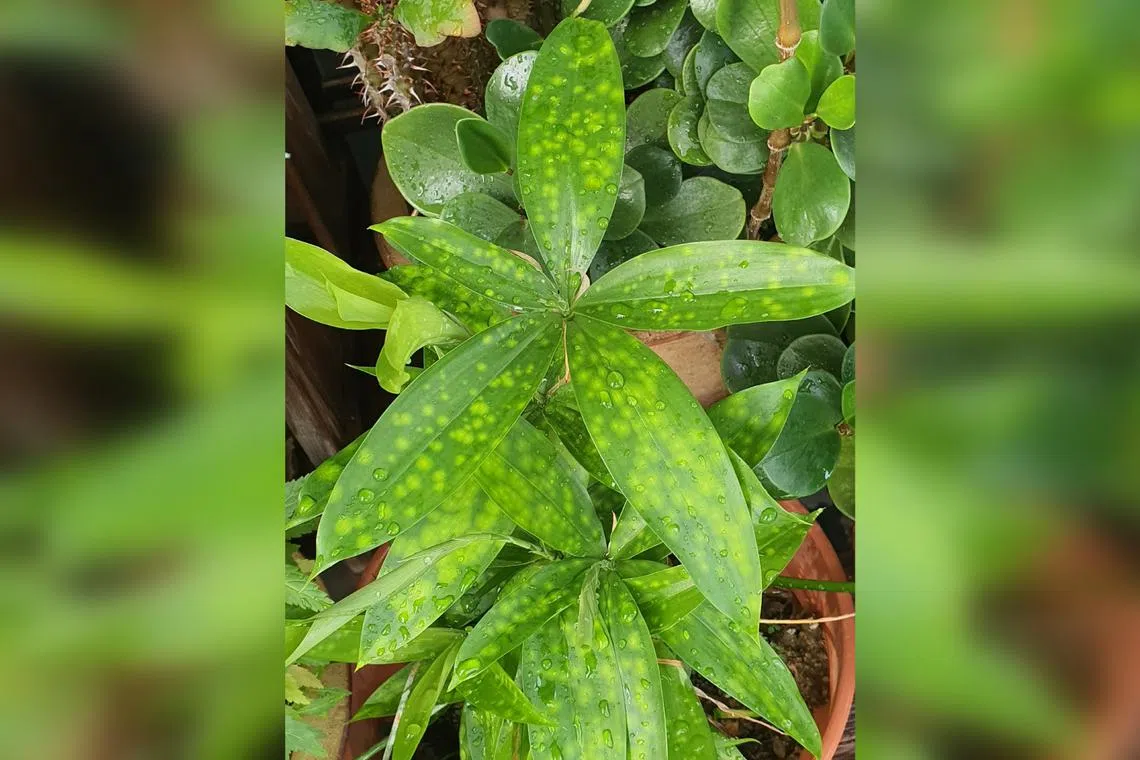Root Awakening: Yellow spots are common on Dracaena surculosa
Sign up now: Get ST's newsletters delivered to your inbox

If the spots appeared during or after a wet season, they could be fungal in nature.
PHOTO: TIM BOK
Wilson Wong
Follow topic:
Move plant to brighter, better ventilated spot
My plant is thriving, but the leaves have discoloured patches. I cut off the affected leaves, but the new ones have the same problem. What should I do?
Tim Bok
When did the yellow spots appear on your Dracaena surculosa?
If they appeared during or after a wet season, the spots could be fungal. You may need to move the plant somewhere brighter with better air circulation. Consider applying preventive fungicide, which you can buy at local nurseries, during these periods to reduce the likelihood of disease.
If this is not the case, yellow spots are commonly found on this plant, especially on the all-green version. They are thought to be caused by a virus, but do not affect the health or growth of the plant.
Brown leaves should be removed from rosemary

The leaves of this rosemary may be browning due to excess or insufficient water.
PHOTO: YEO SI MIN
What is wrong with my rosemary? It seems to be browning from the bottom up. Are the brown tips of the leaves safe to consume after washing? I water it weekly and it gets full-day sun.
Yeo Si Min
The brown leaves found near the base of your plant could be due to a number of reasons. The rosemary is a sun-loving plant and affected leaves will die if it is grown in a shaded spot where very little sunlight reaches the base of the plant.
Another reason could be a lack of water. Although this species is somewhat drought-tolerant, it should not be allowed to dry out totally, as this can cause leaves to turn brown.
It may also be browning due to wet feet. It is essential to understand your growing environment and the best practices required.
The brown leaves are not aesthetically pleasing and, as the cause of browning cannot be clearly ascertained, it is best to prune and discard them.
Grow pomegranate under direct sun in well-draining soil

The pomegranate plant should not be allowed to dry out totally.
PHOTO: LILLIAN WEE
I bought a pomegranate plant for Chinese New Year. A few weeks later, the leaves started to turn yellow. I water the plant every day. Is this normal? How can I prevent the leaves from yellowing?
Lillian Wee
This species is a sun-loving plant. Many home gardeners do not give it enough sunlight for healthy growth, which can cause its leaves to turn yellow and fall off. Ensure your plant gets at least six hours of direct sunlight a day.
Also, do not overwater your plant, as the pomegranate plant does not tolerate prolonged wet feet. It needs well-draining soil that is allowed to dry out between each watering. If the plant does not get enough light, its water intake will be reduced, which can lead to various issues.
If your area is very windy and hot, ensure your plant does not dry out totally. Such conditions can damage or kill the roots, which can also hinder the plant’s water intake and result in yellowing leaves.
Plant is a climbing vine

The Bower Vine is a climbing plant with fragrant flowers.
PHOTO: RAYMOND YEO
What is this plant and does it have shallow or deep roots? I would like to grow it in a planter box about 20cm deep.
Raymond Yeo
The plant appears to be the Bower of Beauty or Bower Vine. Its botanical name is Pandorea jasminoides and it grows as a climbing vine with fragrant flowers.
This plant can get quite large with time, so ensure your planter box has sufficient soil volume to support its growth. Vines grown in small planter boxes can dry quickly and become pot-bound, which can cause the plants to decline.
Banana plants need direct sunlight to thrive

Different banana cultivars will grow and begin fruiting at different rates.
PHOTO: MARY GEORGE CHERIYAN
I grow this dwarf banana plant in my backyard. I fertilise it regularly and add compost. The area is surrounded by tall trees. How can I promote its growth and fruiting? What kind of fertiliser works best and how often should I feed it? I have grown taller banana plants in that same spot and they produced fruit, though it took some time.
Mary George Cheriyan
It is good that you feed your banana plant regularly and add organic materials, like compost, to improve the soil structure.
This species needs fertilisers rich in nitrogen and potassium with added nutrients like magnesium and calcium. You can buy slow-release fertiliser pellets from local nurseries and apply them according to the instructions on the product label.
If you have just planted this dwarf banana plant, it will take time for a healthy root system to develop and for the plant to have a growth spurt. Banana plants need sun to thrive, so make sure it gets at least six hours of direct sunlight a day for robust growth. Different cultivars will grow and begin fruiting at different rates.
Answers by Dr Wilson Wong, an NParks-certified practising horticulturist and parks manager. He is the founder of Green Culture Singapore and an adjunct assistant professor (Food Science & Technology) at the National University of Singapore.
Have a gardening query? E-mail it with clear, high-resolution pictures of at least 1MB, if any, and your full name to . We reserve the right to edit and reject questions.

